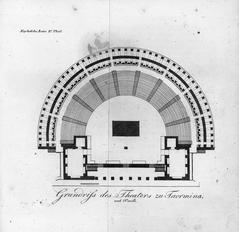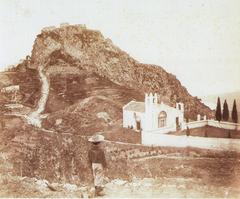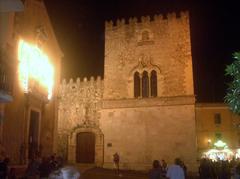Porta Catania: Complete Guide to Visiting Hours, Tickets, and Taormina’s Historic Gateway
Date: 14/06/2025
Introduction
Porta Catania is one of the most iconic and historically significant gateways to Taormina, Sicily. Serving as the southern entrance to the bustling Corso Umberto I, this medieval stone archway is not only a testament to Taormina’s layered past—from its Greek origins through Roman, Byzantine, Arab, Norman, and Aragonese periods—but also a vibrant civic landmark. This guide details Porta Catania’s history, architectural features, visiting hours, ticket information, accessibility, and practical tips for exploring Taormina’s most enchanting urban entryway (enjoysicilia.it; thehistoriantraveller.com; Linda on the Run).
Table of Contents
- Historical Overview
- Architectural Features and Symbolism
- Porta Catania’s Role in Taormina’s Urban Landscape
- Visiting Porta Catania: Hours, Tickets & Accessibility
- Getting There: Location and Transportation
- Practical Tips for Visitors
- Nearby Attractions
- Local Culture, Shopping & Dining
- Frequently Asked Questions
- Visuals and Interactive Elements
- Conclusion
Historical Overview
Origins and Development
Porta Catania dates back to the 15th century, constructed predominantly under the Aragonese dynasty. The gate’s location and fortification were integral to the city’s defenses, forming part of Taormina’s second city wall system originally expanded by the Arabs in the 9th–11th centuries. The city’s triple wall system, with Porta Messina to the north and Porta Catania to the south, reflects Taormina’s strategic importance throughout its history (enjoysicilia.it).
Strategic and Civic Importance
Beyond its military function, Porta Catania has long served as a civic center. During Norman rule, the adjacent square was known for public meetings held at the “hour of the touch”—the first hour after noon. This tradition gave the gate its alternative name, “Porta del Tocco” (enjoysicilia.it). Over the centuries, the gate has witnessed Taormina’s transitions through Greek, Roman, Byzantine, Arab, Norman, and Spanish dominations (thehistoriantraveller.com).
Architectural Features and Symbolism
Porta Catania’s pointed arch, built from local stone, is crowned by aedicules containing the Aragonese coat of arms and the date of its restoration (1440). The fusion of Norman and Aragonese styles, including decorative reliefs like the image of Saint Nicholas, reflects the complex political and religious identity of Taormina (enjoysicilia.it).
Next to the gate stands the 14th-century Palazzo dei Duchi di Santo Stefano, further enhancing the area’s medieval character.
Porta Catania’s Role in Taormina’s Urban Landscape
Porta Catania anchors the southern end of Corso Umberto I, Taormina’s main pedestrian thoroughfare. This street, tracing the ancient Valeria road, is lined with historic buildings, artisan shops, and cafés. The gate remains a key meeting point for locals and visitors, serving as a starting or ending point for walking tours and a symbolic threshold between the city center and its surroundings (thehistoriantraveller.com; The Orange Backpack).
Visiting Porta Catania: Hours, Tickets & Accessibility
Visiting Hours
- Open 24/7: Porta Catania is an open-air monument, accessible at any time, day or night.
Tickets
- Free Entry: There is no admission fee to visit Porta Catania itself. Entry to the gate and the adjacent pedestrian zone is unrestricted.
Accessibility
- Wheelchair Access: The area around Porta Catania is flat and generally accessible, though some nearby cobbled streets may present challenges.
- Restrooms & Amenities: Public restrooms are available in the nearby parking lot and along Corso Umberto.
Getting There: Location and Transportation
Porta Catania is located at the southwestern edge of Taormina’s old town, at the end of Corso Umberto I.
- By Car: Park at Parcheggio Porta Catania, the main parking structure nearby (Nannybag).
- By Train: Arrive at Taormina-Giardini station, then take a bus or taxi to Porta Catania (Out of Office Mindset).
- By Bus: Regional buses stop at Taormina’s bus terminal, a 10–15 minute walk from Porta Catania.
- On Foot: Porta Catania is a short, pleasant walk from anywhere in the historical center (Linda on the Run).
Practical Tips for Visitors
- Best Times: Early morning and late afternoon offer softer light and fewer crowds.
- Seasonal Advice: Visit in shoulder months (April–June, September–October) for milder weather and thinner crowds.
- Footwear: Wear comfortable shoes for cobblestone streets.
- Luggage: Storage is available near the train station and parking garages (Nannybag).
- Local Etiquette: Shops close for riposo (1:00–4:00pm). Tipping is appreciated but not obligatory.
Nearby Attractions
- Corso Umberto I: Main shopping and strolling street, lined with boutiques, cafés, and historic architecture (The Orange Backpack).
- Piazza Duomo & Cathedral of San Nicola: A short walk from Porta Catania, this square features a fortress-like church and a Baroque fountain (PlanetWare).
- Palazzo dei Duchi di Santo Stefano: 14th-century palace, often hosting art exhibitions (Visit Italy).
- Teatro Greco: Ancient Greek theatre with panoramic views, about a 15-minute walk away (PlanetWare).
- Isola Bella: Nature reserve and beach, reachable by cable car from the town center (Rachel IRL).
- Public Gardens (Giardini della Villa Comunale): Terraced gardens with sea views (Salt in Our Hair).
- Castelmola: Hilltop village with panoramic views, accessible by bus or taxi (Visit Italy).
Local Culture, Shopping & Dining
- Artisan Shops: Corso Umberto I is famous for Sicilian ceramics, jewelry, and gourmet foods (Visit Italy).
- Cafés & Eateries: Enjoy local specialties like cannoli, almond wine, seafood, and granita (Sicily Adventure; Salt in Our Hair).
- Evening Atmosphere: The area is lively at night, with illuminated streets, outdoor dining, and occasional live music (Salt in Our Hair).
Frequently Asked Questions
Q: What are Porta Catania’s opening hours?
A: The gate is open 24 hours a day, year-round.
Q: Is there an entrance fee for Porta Catania?
A: No, it is a free public monument.
Q: Is Porta Catania wheelchair accessible?
A: The immediate area is accessible, but some streets have cobblestones.
Q: Are guided tours available?
A: Yes, many walking tours include Porta Catania (Rachel IRL).
Q: Can I park near Porta Catania?
A: Yes, Parcheggio Porta Catania is nearby.
Visuals and Interactive Elements
- [Insert image: “Porta Catania at sunset” – alt text: “Historic Porta Catania arch in Taormina with Aragonese crest”]
- [Insert map: Porta Catania’s location within Taormina and nearby landmarks]
- [Consider: Virtual tour or video walk-through of Porta Catania and Corso Umberto]
Conclusion
Porta Catania is much more than a historic gate—it’s a living emblem of Taormina’s resilience, cultural layers, and vibrant community life. With free, round-the-clock access, proximity to key attractions, and a central role in the city’s pedestrian heart, it provides the ideal starting point for exploring Taormina’s medieval streets, artisan shops, and scenic vistas.
Plan your visit today, make use of the Audiala app for guided tours and insider tips, and immerse yourself in the authentic rhythms of Sicilian heritage!
References
- enjoysicilia.it
- thehistoriantraveller.com
- Linda on the Run
- The Orange Backpack
- Rachel IRL
- Nannybag
- Out of Office Mindset
- Sicily Adventure
- Salt in Our Hair
- Visit Italy
- PlanetWare
- Wanderlust Storytellers



